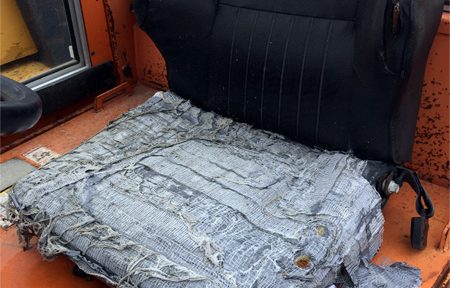Replace Broken Forklift Seats Promptly
 In most busy operations, small annoyances often take a back seat to urgent demands. For example, when you have a full pull sheet or a long list of jobs to accomplish with your forklift during your shift, you probably aren’t going to stop to repair a rip in your forklift seat or worry that it doesn’t move back or forward when you adjust it.
In most busy operations, small annoyances often take a back seat to urgent demands. For example, when you have a full pull sheet or a long list of jobs to accomplish with your forklift during your shift, you probably aren’t going to stop to repair a rip in your forklift seat or worry that it doesn’t move back or forward when you adjust it.
But little problems can lead to much bigger issues if they aren’t addressed promptly. A small tear in your forklifts’ seat isn’t going to get any smaller. Instead, it’s just going to grow larger and larger with wear and use until it poses a potential hazard to operators on every shift.
And if the seat can’t be adjusted easily during your shift, eventually it’s likely that it won’t be able to be moved at all. So drivers will have to use whatever position setting it gets stuck on, which is not only uncomfortable but also potentially dangerous.
Repairing Forklift Seats
Forklift seats need to be fully operational in order to be safe. Drivers may spend many hours in the saddle. So their comfort and security are essential to their health and safety.
Some problems with forklift seats are easily repairable. For example, a stubborn seat can often be repaired with a little oil or by readjusting or repairing the spring mechanism.
Taking a forklift out of service for a short period of time to make a minor repair or adjustment is often better than ignoring the problem until it worsens. When little problems become major issues, everybody is in danger.
Forklift Replacement Seats
Avoid the temptation to “tape over” problems such as rips and tears in forklift seats. While duct tape has a lot of miraculous uses — including making on the fly repairs to forklift seats — these types of quick fixes can easily get out of hand (see illustration).
Instead, consider replacing forklift seats when they are in disrepair. Small rips and tears are a sign of wear. There may be other internal problems that are not as visible but pose a bigger danger to the comfort and safety of the operator.
If you have a large enough fleet, you may even consider keeping a spare forklift seat or two on hand so that seats can be replaced instantly without having to wait for a replacement part to be shipped.
Make checking forklift seats a part of every pre- and post-shift inspection that operators are required to perform. This will help you identify little problems before they turn into major issues.

